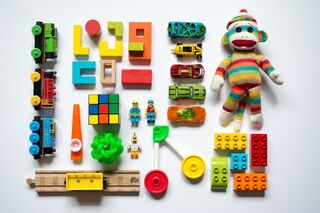Play
Clutter Is Children’s Creative Play
What do children really need from their environment?
Posted September 26, 2022 Reviewed by Davia Sills
Key points
- Toys matter for infants' healthy development.
- Research shows that creatives tend to break the rules.
- Clutter is often associated with creativity in early development and even adulthood.
What do a brochure for the Hong Kong Pavilion New York City Toy Fair, a 16 euro receipt from Brussels to Ghent, the creative play retailer guide, a gold sharpie, two birthday cards, a matcha cup filled with hot coffee and steamed milk, two stamps, an audio cable, and a copy of Doing Developmental Research have in common? You guessed it. It’s all the clutter that I found on my desk this morning. Let’s not even talk about the wool Max Mara blazers on the shelf behind me, playing a game of tug of war with my innocent brain. In today’s match, it’s Lose 10 lbs vs. We Will Fit You Again! Who will win, you ask? Maybe that blazer would spark joy—if I lost 10 lbs. It’s not that simple, is it, Marie Kondo?
Organizing feels something like a WWE Smackdown match. Here’s a confession. I prefer to eat Doritos than find matches for my orphan socks. In fact, it sparks my joy to wear socks that don’t match. It’s breaking the rules—and that’s the key to creativity. Research shows that rule-breaking and creativity go hand-in-hand.
Breaking the Rules and Creative Thinking for Children
You are what you look at, and most of us are probably looking at too much. That is if we like to eat apples rather than chocolate and give more of our money away to charity. According to research conducted by the Carlson School of Management at the University of Minnesota, “Physical Order Produces Healthy Choices, Generosity, and Conventionality, Whereas Disorder Produces Creativity.” The researchers compared how adult behavior changed as a function of the environment. In one experiment, the researchers showed that relative to adults in a disorderly room, adults in an orderly room preferred to eat apples compared to candy, and they donated more money to a charity. In another study, adults who were in a disorderly room were more creative than those in an organized room. That is, their divergent thinking skills were better when they were in a disorganized room compared to an organized one.
Our physical environment shapes what and how we eat, how we behave, and how we feel. The same philosophy applies to babies and children, of course. Infants are deeply sensitive to their physical environments, and unlike adults, they have little control over their environments. They may cry or try to crawl away from a physical environment that they do not like, but overall, infants are susceptible to the design and environmental choices of the adults around them. How might these choices come into play?
Research shows that infant behavior is influenced by the mere number of toys that they are provided. Researchers from the University of Toledo in Ohio invited toddlers to the laboratory and had the babies play in two different conditions. In one condition, infants were given 16 toys to play with, and in another condition, infants were given four toys. Their behavior was then analyzed after a free play session. When babies played with fewer toys, they explored these toys for longer time durations and played with these toys in a greater variety of ways. This means that playing with fewer toys may foster more flexible and creative thinking.
Less may be more—but it is also important to remember that the quality and types of toys that we provide children matter. The design of some toys may promote more language development and foster more creativity. According to research from the Max Planck Institute for Evolutionary Anthropology, Social and Object Support for Early Symbolic Play, children’s symbolic play increases between 2 and 3 years of age. Symbolic play is a special type of play. Think of it like putting a baby doll into a crib or a banana up to one’s ear as if making a telephone call. Symbolic play and language development are related in early development.
Now let’s put ourselves in the shoes of a developing baby for a moment. A doll is a replica toy that can be touched and manipulated, but it is also a possible symbol—a symbol that represents a real baby. This has been called a dual representation problem by scholars of developmental science. In a nutshell, it is hard for young babies to comprehend that an object is something that can be manipulated and also a symbol for something else.

It’s no wonder that when we watch a 6-month-old baby playing with a doll, we will observe the baby exploring the object with hands and mouth—not intentionally putting the doll into a crib. The object is not yet a symbol for the baby. But over development, this changes.
Rocks, Nature, and Creative Thinking
By the second year, children become more flexible in their thinking and ability to represent. They begin to understand and use a doll in a symbolic way when they put it in a crib. Interestingly, young children are more flexible in their thinking when objects have no obvious function. This is highlighted in the research, “Do Young Children Use Objects as Symbols?”
According to research by Tricia Striano, Michael Tomasello, and Philippe Rochat, a child is more open to using a rock to represent a baby than a pencil. This is because the child has learned the conventional use of a pencil. The child has learned that a pencil is used to write and draw. Rocks are more flexible in nature because they have no conventional affordance.
It’s no wonder that research shows that walking in nature boosts creativity. Objects speak to us and play an important role in the nature of our interactions with babies and children. Objects have a profound influence on the developing and the adult mind. The designs and objects that we select for our homes and playrooms are like babies—they speak to us but have no words.




